英语中的就近原则和就远原则
- 格式:pptx
- 大小:265.82 KB
- 文档页数:6
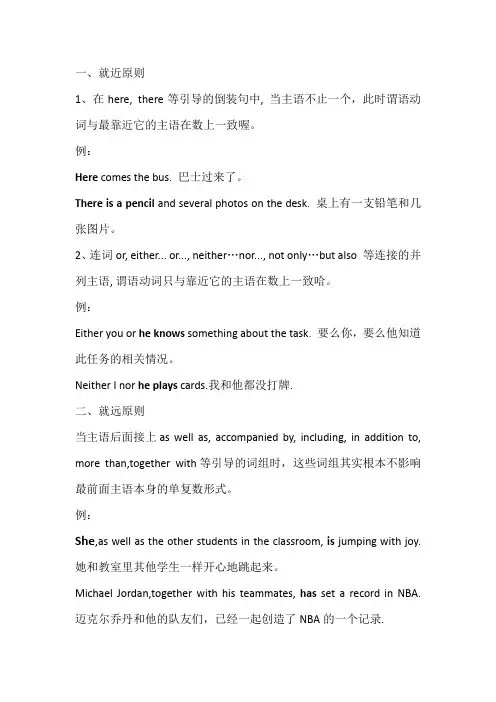
一、就近原则
1、在here, there等引导的倒装句中, 当主语不止一个,此时谓语动词与最靠近它的主语在数上一致喔。
例:
Here comes the bus. 巴士过来了。
There is a pencil and several photos on the desk. 桌上有一支铅笔和几张图片。
2、连词or, either... or..., neither…nor..., not only…but also 等连接的并列主语, 谓语动词只与靠近它的主语在数上一致哈。
例:
Either you or he knows something about the task. 要么你,要么他知道此任务的相关情况。
Neither I nor he plays cards.我和他都没打牌.
二、就远原则
当主语后面接上as well as, accompanied by, including, in addition to, more than,together with等引导的词组时,这些词组其实根本不影响最前面主语本身的单复数形式。
例:
She,as well as the other students in the classroom, is jumping with joy.她和教室里其他学生一样开心地跳起来。
Michael Jordan,together with his teammates,has set a record in NBA. 迈克尔乔丹和他的队友们,已经一起创造了NBA的一个记录.。

就远原则顺口溜
英语就近原则和就远原则口诀是就近,就近,谓语最近,就远,就远,隔得很远。
就近原则和就远原则是指英语语法原则。
就近原则也称“邻近原则”“就近一致原则”(Proximity),即:谓语与靠近的名词、代词(有时不一定是主语)在“人称、数”上一致。
就远原则就是谓语动词的变化,谓语动词与前面主语一致。
英语学习技巧:
1、学好英语离不开语言环境。
如何快速学好英语?学习英语要抓住本质,英语是一门语言学科,离不开沟通和交流,营造语言环境可以很好地均衡语言的输入和输出。
英语不同于我们的母语汉语,它是一种表音文字,也就是说,掌握了正确的发音方式,孩子才能更好地理解对话内容。
2、学好英语的基础是加强听说。
英语的学习需要遵循“听说,后读写”的客观顺序,反观传统的英语课堂,一味地要求孩子死记硬背,侧重应试能力的培养,听力训练不够,大班教学孩子开口的机会少之又少。
3、学好英语要培养良好的习惯。
学好英语是需要花费一定的时间和精力的,坚持下去才能更好地掌握这门语言。
所以,学习环境也很重要,大家在学习中一定要创造良好的学习环境。
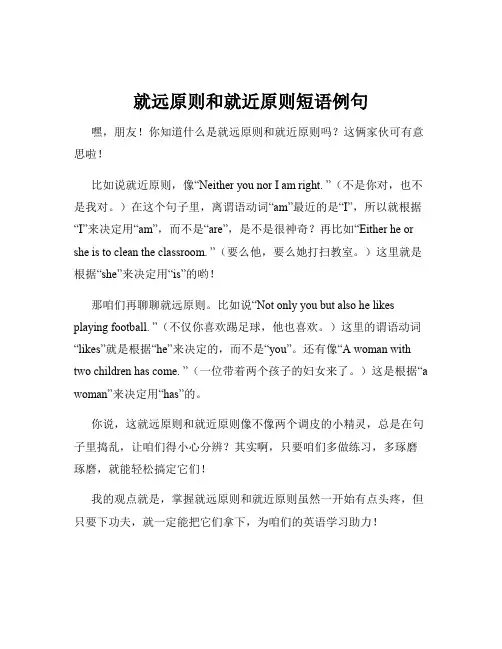
就远原则和就近原则短语例句嘿,朋友!你知道什么是就远原则和就近原则吗?这俩家伙可有意思啦!
比如说就近原则,像“Neither you nor I am right. ”(不是你对,也不是我对。
)在这个句子里,离谓语动词“am”最近的是“I”,所以就根据“I”来决定用“am”,而不是“are”,是不是很神奇?再比如“Either he or she is to clean the classroom. ”(要么他,要么她打扫教室。
)这里就是根据“she”来决定用“is”的哟!
那咱们再聊聊就远原则。
比如说“Not only you but also he likes playing football. ”(不仅你喜欢踢足球,他也喜欢。
)这里的谓语动词“likes”就是根据“he”来决定的,而不是“you”。
还有像“A woman with two children has come. ”(一位带着两个孩子的妇女来了。
)这是根据“a woman”来决定用“has”的。
你说,这就远原则和就近原则像不像两个调皮的小精灵,总是在句子里捣乱,让咱们得小心分辨?其实啊,只要咱们多做练习,多琢磨琢磨,就能轻松搞定它们!
我的观点就是,掌握就远原则和就近原则虽然一开始有点头疼,但只要下功夫,就一定能把它们拿下,为咱们的英语学习助力!。
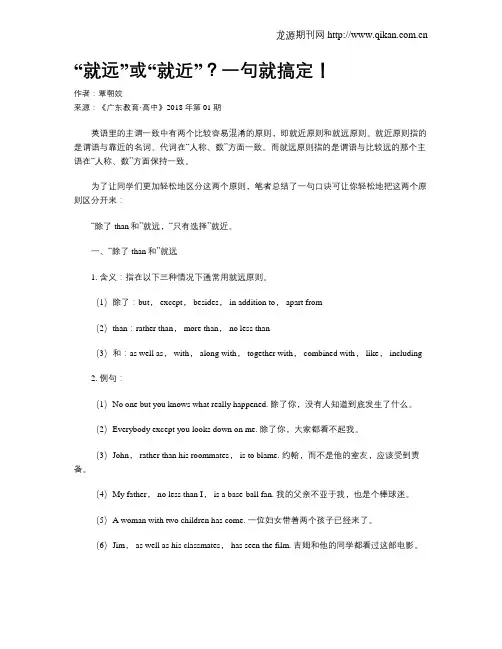
“就远”或“就近”?一句就搞定!作者:覃朝姣来源:《广东教育·高中》2018年第01期英语里的主谓一致中有两个比较容易混淆的原则,即就近原则和就远原则。
就近原则指的是谓语与靠近的名词、代词在“人称、数”方面一致。
而就远原则指的是谓语与比较远的那个主语在“人称、数”方面保持一致。
为了让同学们更加轻松地区分这两个原则,笔者总结了一句口诀可让你轻松地把这两个原则区分开来:“除了than和”就远,“只有选择”就近。
一、“除了than和”就远1. 含义:指在以下三种情况下通常用就远原则。
(1)除了:but, except, besides, in addition to, apart from(2)than:rather than, more than, no less than(3)和:as well as, with, along with, together with, combined with, like, including2. 例句:(1)No one but you knows what really happened. 除了你,没有人知道到底发生了什么。
(2)Everybody except you looks down on me. 除了你,大家都看不起我。
(3)John, rather than his roommates, is to blame. 约翰,而不是他的室友,应该受到责备。
(4)My father, no less than I, is a base-ball fan. 我的父亲不亚于我,也是个棒球迷。
(5)A woman with two children has come. 一位妇女带着两个孩子已经来了。
(6)Jim, as well as his classmates, has seen the film. 吉姆和他的同学都看过这部电影。
(7)Mr Green, together with his wife and children, has come to China. 格林先生,以及他的妻儿,已经来到中国。
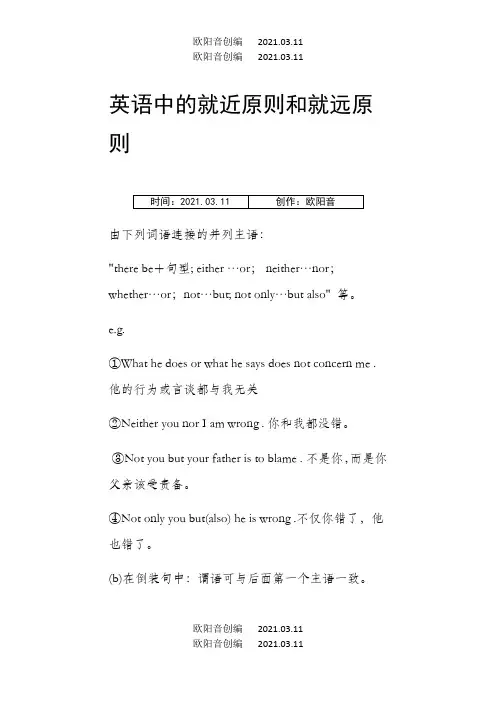
英语中的就近原则和就远原则由下列词语连接的并列主语:"there be+句型; either …or;neither…nor;whether…or;not…but; not only…but also" 等。
e.g.①What he does or what he says does not concern me . 他的行为或言谈都与我无关②Neither you nor I am wrong . 你和我都没错。
③Not you but your father is to blame . 不是你,而是你父亲该受责备。
④Not only you but(also) he is wrong .不仅你错了,他也错了。
(b)在倒装句中:谓语可与后面第一个主语一致。
欧阳音创编2021.03.11e.g.①In the distance was heard the clapping of hands and the shouts of the people .在远处,能听见鼓掌声和人们的呼喊声。
②There is (are) a pen and some books on the desk .桌上有一支钢笔和几本书。
就远原则.就远原则就是依主语来决定,有as much as. rather than. more than. no less than. as well a s. in addition to. with. etc...No one except (but) me knows about this news. 除了我没有人知道一、就近原则:由or, either…or, neither…or, not… but…, not only…but also等连接的并列成分作主语时,其谓语通常要与靠近的主语保持一致。
如:He or I am in the wrong, 他或是我错了。

英语中的就近准绳和就远准绳之杨若古兰创作由以下词语连接的并列主语:"there be+句型; either …or;neither…nor;whether…or;not…but; not only…but also" 等.e.g.①What he does or what he says does not concern me . 他的行为或言谈都与我有关②Neither you nor I am wrong . 你和我都没错.③Not you but your father is to blame . 不是你,而是你父亲该受求全.④Not only you but(also) he is wrong .不但你错了,他也错了.(b)在倒装句中:谓语可与后面第一个主语分歧.e.g.①In the distance was heard the clapping of hands and the shouts of the people .在远处,能听见鼓掌声和人们的呼喊声.②There is (are) a pen and some books on the desk .桌上有一支钢笔和几本书.就远准绳.就远准绳就是依主语来决定,有as much as. rather than. more than. no less than. as well as. in addit ion to. with. etc...No one except (but) me knows about this news. 除了我没有人晓得一、就近准绳:由or, either…or, neither…or, not… but…, not only…but also等连接的并列成分作主语时,其谓语通常要与靠近的主语坚持分歧.如:He or I am in the wrong, 他或是我错了.Neither you nor he is tired. 你和他都没累.Not you but I am to blame. 不该怪你而该怪我.Either my father or my brothers are coming. 不是我父亲就是我兄弟要来.Not only the students but also their teacher is enjoying the film. 不但先生们在观赏这部影片,他们的老师也在观赏这部影片.但在非正式体裁中,有时也一概用复数谓语(注:在考试时最好防止使用).如:Neither Ted nor Mark are wrong. 特德和马克都没有错.If either David or Janet come, they will want a drink. 大卫或珍妮特来了的话,是会要喝酒的.二、就远准绳当用作主语的成分后面跟有由but, except, besides, including, like, with, as well as, as much as, no less than, along with, in addition to, combined with, rather than, together with等引出的短语时,谓语动词习气上要与这些结构前面的主语坚持分歧(即与比较远的那个主语坚持分歧,简称“就远准绳”).如:Everybody except you is down on me. 除了你,大家都看不起我.A woman with two children has come. 一名妇女带着两个孩子曾经来了.John, rather than his roommates, is to blame. 约翰,而不是他的室友,应当受到求全.Jim, together with his classmates, has seen the film. 吉姆和他的同学都看过这部电影.My father, no less than I, is a base-ball fan. 我的父亲不亚于我也是个棒球迷.。

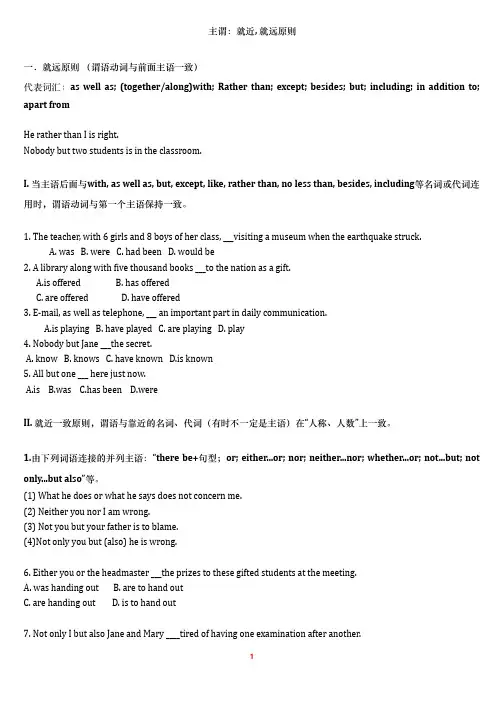
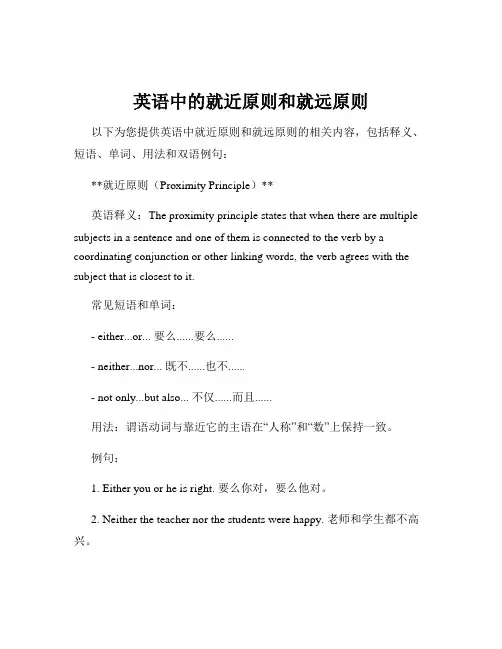
英语中的就近原则和就远原则以下为您提供英语中就近原则和就远原则的相关内容,包括释义、短语、单词、用法和双语例句:**就近原则(Proximity Principle)**英语释义:The proximity principle states that when there are multiple subjects in a sentence and one of them is connected to the verb by a coordinating conjunction or other linking words, the verb agrees with the subject that is closest to it.常见短语和单词:- either...or... 要么......要么......- neither...nor... 既不......也不......- not only...but also... 不仅......而且......用法:谓语动词与靠近它的主语在“人称”和“数”上保持一致。
例句:1. Either you or he is right. 要么你对,要么他对。
2. Neither the teacher nor the students were happy. 老师和学生都不高兴。
3. Not only Tom but also his parents are coming. 不仅汤姆,而且他的父母也要来。
4. Either my sisters or my brother is going on a trip. 要么我的姐妹们,要么我的哥哥要去旅行。
5. Neither she nor I am to blame. 她和我都不应受责备。
6. Not only the students but also the teacher has been to the museum. 不仅学生们,老师也去过博物馆。
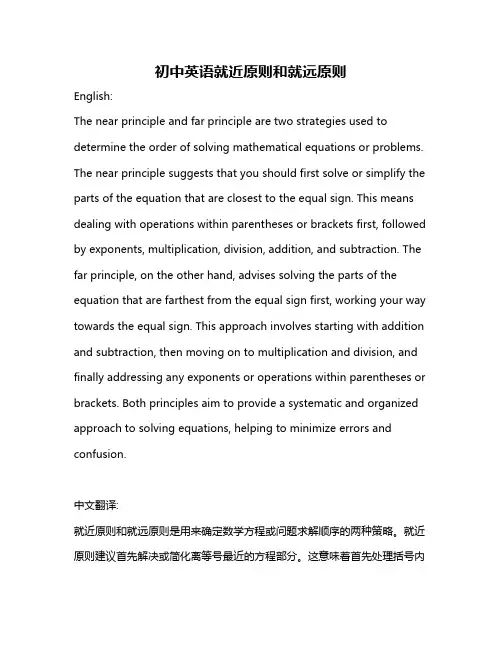
初中英语就近原则和就远原则English:The near principle and far principle are two strategies used to determine the order of solving mathematical equations or problems. The near principle suggests that you should first solve or simplify the parts of the equation that are closest to the equal sign. This means dealing with operations within parentheses or brackets first, followed by exponents, multiplication, division, addition, and subtraction. The far principle, on the other hand, advises solving the parts of the equation that are farthest from the equal sign first, working your way towards the equal sign. This approach involves starting with addition and subtraction, then moving on to multiplication and division, and finally addressing any exponents or operations within parentheses or brackets. Both principles aim to provide a systematic and organized approach to solving equations, helping to minimize errors and confusion.中文翻译:就近原则和就远原则是用来确定数学方程或问题求解顺序的两种策略。

就远原则和就近原则的用法
1. 嘿,你知道吗?就远原则里啊,当句子的主语后面跟着“with, together with, along with”这些词的时候,可别被误导啦,谓语动词要和最前面那个主语保持一致哟!就像“John, together with his friends, goes to the park.”这里可是要看 John 而不是他朋友哦,神奇吧!
2. 哎呀呀,还有像“as well as, rather than”这些词出现时,也是就
远原则呢!比如“She, rather than her sister, likes dancing.”重点在她
而不是她妹妹呀!
3. 嘿,就近原则也很有意思呀!当看到“or, either…or, neither…nor”这些词的时候,谓语就要和最近的主语一致啦!像“Either he or I am right.”到底是他对还是我对呢?
4. 还有呢,像“There be”句型不也是就近原则嘛!“There is a pen and two books on the table.”看,就是离 is 最近的那个来决定呢!
5. 哇塞,你想想看,这些规则就像小魔法一样控制着句子的走向,是不是很奇妙呀!
6. 难道你不想把这些规则像宝贝一样收藏起来,在英语学习中随时拿出来用吗?
7. 总之呢,搞清楚就远原则和就近原则的用法,对我们英语学习可太重要啦!一定要好好记住哦!。
英语中的就近原则和就远原则
由下列词语连接的并列主语:"there be+句型; either …or;neither…nor;whether…or;not…but; not only…but also" ; 等。
e.g. ①What he does or what he says does not concern me . 他的行为或言谈都与我无关
②Neither you nor I am wrong . 你和我都没错。
③Not you but your father is to blame . 不是你,而是你父亲该受责备。
④Not only you but(also) he is wrong .不仅你错了,他也错了。
(b)在倒装句中:谓语可与后面第一个主语一致。
e.g. ①In the distance was heard the clapping of hands and the shouts of the people .
在远处,能听见鼓掌声和人们的呼喊声。
②There is (are) a pen and some books on the desk .桌上有一支钢笔和几本书。
就远原则.
就远原则就是依主语来决定,有as much as. rather than. more than. no less than.
as well as. in addition to. with. etc...
No one except (but) me knows about this news. 除了我没有人知道。